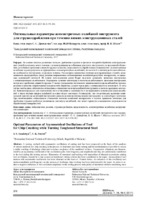| dc.contributor.author | Данильчик, С. С. | ru |
| dc.contributor.author | Шелег, В. К. | ru |
| dc.coverage.spatial | Минск | ru |
| dc.date.accessioned | 2017-10-07T18:11:13Z | |
| dc.date.available | 2017-10-07T18:11:13Z | |
| dc.date.issued | 2017 | |
| dc.identifier.citation | Данильчик, С. С., Шелег В. К. Оптимальные параметры асимметричных колебаний инструмента для стружкодробления при точении вязких конструкционных сталей = Optimal Parameters of Asymmetrical Oscillations of Tool for Chip Crushing while Turning Toughened Structural Steel / С. С. Данильчик, В. К. Шелег // Наука и техника. – 2017. – № 5. - С. 376-382. | ru |
| dc.identifier.uri | https://rep.bntu.by/handle/data/33329 | |
| dc.description.abstract | На основе анализа различных методов дробления стружки в процессе токарной обработки конструкционных сталей предложен метод точения с асимметричными колебаниями режущего инструмента, позволяющий обеспечить устойчивое дробление сливной стружки и снизить шероховатость обработанных поверхностей. Асимметричные колебания характеризуются коэффициентом асимметрии цикла колебаний, их частотой и амплитудой и дополнительно сообщаются инструменту в процессе точения. Рассмотрена кинематика точения конструкционных сталей с наложением на традиционную схему резания направленных асимметричных колебаний режущего инструмента, создаваемых кулачковой системой. На основе использования рядов Фурье получено уравнение движения инструмента с асимметричными колебаниями. Определено влияние амплитуды и частоты колебательного движения инструмента на процесс дробления сливной стружки. С целью уменьшения негативного влияния амплитуды колебаний на процесс резания и качество обработанных поверхностей обработку следует проводить с минимальной ее величиной. В этом случае необходимо обеспечить оптимальное отношение частоты колебаний инструмента к частоте вращения заготовки. Выведена формула для определения этого отношения в зависимости от коэффициента асимметрии цикла колебаний и числа полных циклов колебаний за один оборот заготовки. Установлено, что теоретическая величина минимальной амплитуды колебаний инструмента равна половине величины подачи инструмента за один оборот заготовки. При несоблюдении оптимального отношения частоты колебаний инструмента к частоте вращения заготовки для дробления стружки требуется увеличивать амплитуду колебаний, что может привести к повышению шероховатости обработанных поверхностей. | ru |
| dc.language.iso | ru | ru |
| dc.publisher | БНТУ | ru |
| dc.title | Оптимальные параметры асимметричных колебаний инструмента для стружкодробления при точении вязких конструкционных сталей | ru |
| dc.title.alternative | Optimal Parameters of Asymmetrical Oscillations of Tool for Chip Crushing while Turning Toughened Structural Steel | en |
| dc.type | Article | ru |
| dc.identifier.doi | 10.21122/2227-1031-2017-16-5-376-382 | |
| local.description.annotation | A turning method with asymmetric oscillations of cutting tool has been proposed on the basis of the analysis of various methods for chip crushing in the process of structural steel lathe turning and the method makes it possible to ensure a stable crushing of discharge chips and to reduce roughness of the machined surfaces. Asymmetric vibrations are characterized by an asymmetry coefficient of the oscillation cycle, their frequency and amplitude and they are additionally transferred to the tool during the turning process. Kinematics of structural steel turning with imposition of directed asymmetric cutting tool oscillations created by a cam system on traditional cutting scheme has been considered in the paper. An equation of tool motion with asymmetric oscillations has been obtained on the basis of Fourier Series. An influence of the oscillatory tool motion amplitude and frequency on the process of discharge chip crushing has been determined in the paper. In order to reduce a negative influence of the oscillation amplitude on the cutting process and quality of machined surfaces machining must be carried out with its minimum value. In this case it is necessary to ensure an optimum ratio of the tool oscillation frequency to the rotational speed of a workpiece. A formula has been derived for determination of this ratio according to a coefficient of oscillation cycle asymmetry and number of complete oscillation cycles per one revolution of the workpiece. It has been established that a theoretical value of the minimum tool oscillation amplitude is equal to half of the tool feed value per one revolution of the workpiece. If the optimum ratio of the tool oscillation frequency to workpiece rotation frequency has not been observed for chip crushing it is necessary to increase oscillation amplitude that may lead to an increase of roughness on machined surfaces. | en |

